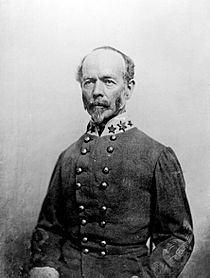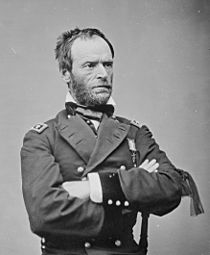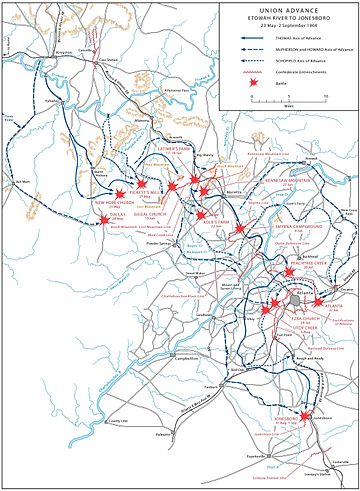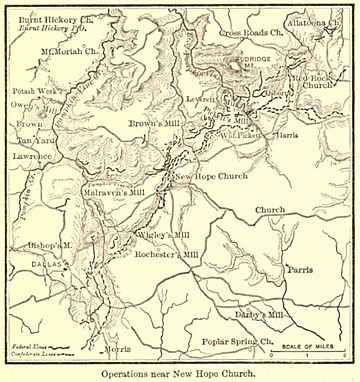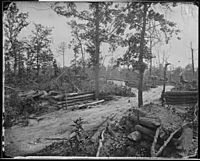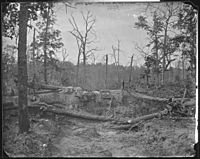Battle of New Hope Church facts for kids
Quick facts for kids Battle of New Hope Church |
|||||||
|---|---|---|---|---|---|---|---|
| Part of the American Civil War | |||||||
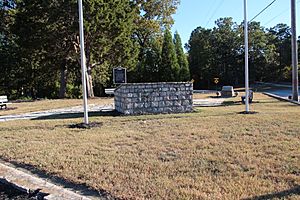 New Hope Battlefield Park, a memorial located at the site of the battle |
|||||||
|
|||||||
| Belligerents | |||||||
| Commanders and leaders | |||||||
| Units involved | |||||||
| Army of Tennessee | Military Division of the Mississippi | ||||||
| Strength | |||||||
| 4,000, 16 guns | 16,000 | ||||||
| Casualties and losses | |||||||
| 400 | 1,665 | ||||||
The Battle of New Hope Church happened on May 25–26, 1864. It was a fight during the American Civil War. The Union Army, led by Major General William T. Sherman, fought against the Confederate Army of Tennessee, led by General Joseph E. Johnston. This battle was part of the larger Atlanta Campaign.
Sherman wanted to force Johnston's army to leave its strong defenses. He tried to move his army around Johnston's side. Sherman thought he had tricked Johnston. But Johnston quickly moved his army to block Sherman's path.
When the Union XX Corps, led by Major General Joseph Hooker, attacked, they faced strong Confederate defenses. Hooker's soldiers were stopped with heavy losses. This battle was a win for the Confederates.
Contents
Why the Battle Happened
Sherman's Plan to Outsmart Johnston
Earlier in May, General Sherman had successfully made Johnston's army retreat several times. Sherman's army crossed the Etowah River. He tried to go around Johnston's left side. Johnston, however, guessed what Sherman was planning.
Sherman believed his path was clear. But Johnston quickly moved his army into a blocking position. At New Hope Church, Hooker's troops attacked hard. But they were strongly pushed back by a Confederate division. This division was part of John Bell Hood's corps and was well-dug in. After this defeat, Sherman decided to try moving around Johnston's right side instead.
Armies Ready for Battle
The Union Army had about 110,000 soldiers. Around 99,000 of them were ready for fighting. They had 254 cannons. Many other people, like railroad workers and medical staff, also traveled with the army.
Sherman commanded three main armies. These were the Army of the Cumberland (about 73,000 troops), the Army of the Tennessee (about 24,500 soldiers), and the Army of the Ohio (about 13,500 soldiers).
The Confederate Army, led by General Johnston, had about 41,000 soldiers ready for duty. They also had 3,200 artillerymen with 144 cannons. About 8,500 cavalry (soldiers on horseback) were also part of Johnston's forces.
Johnston's army included two main groups of infantry. These were led by Lieutenant Generals William J. Hardee and John Bell Hood. A cavalry group was led by Major General Joseph Wheeler. Later, another group led by Lieutenant General Leonidas Polk joined them.
Moving Towards the Fight
Sherman started his campaign on May 7, 1864. He used clever moves to make Johnston's army retreat. First, he went around Johnston's side at the Battle of Rocky Face Ridge. Then came the Battle of Resaca. Johnston kept pulling back.
Johnston tried to attack Sherman at the Battle of Cassville, but it didn't work out. On May 19, Johnston's generals convinced him to retreat to Allatoona Pass. Johnston did this very well, leaving few soldiers behind.
Sherman wanted to force Johnston's army even further back. He decided to go around Johnston's army from the west. His plan was to march to Dallas and then to Marietta. On May 20, Sherman told his army to be ready to move on May 23.
Since they were leaving the railroad, the army carried 20 days of supplies. They also sent all wounded soldiers to the back. Sherman worried about his supply line, which stretched 80 miles (129 km) back to Chattanooga.
Sherman ordered his troops to march. McPherson's two groups went south from Kingston to Van Wert, then east to Dallas. Thomas's three groups marched south through Euharlee and Stilesboro toward Dallas. Schofield's group marched from Cartersville.
Johnston wasn't sure what Sherman was doing. He sent his cavalry to check. On May 24, they reported Sherman's army was near Kingston. Later that day, Sherman's soldiers captured a Confederate messenger. The message said Johnston's army was moving toward Dallas. Even so, Sherman was sure Johnston wouldn't block him at Dallas. He ordered his army to keep moving forward.
The Battle at New Hope Church
On the morning of May 25, Hardee's Confederate corps took positions at Dallas. They blocked the road to Marietta. Polk's corps was next to them. Hood's corps moved into place near New Hope Church, northeast of Dallas.
Hood's soldiers quickly dug trenches and built walls of logs and rocks. Confederate lookouts saw dust clouds, meaning Sherman's troops were coming. That afternoon, Hood's soldiers captured a Union soldier. He said he was from Hooker's corps.
On May 25, McPherson's troops marched toward Dallas. Hooker's XX Corps marched on the road from Burnt Hickory to Dallas. Brigadier General John W. Geary's division was on the main road. At Pumpkinvine Creek, Union soldiers found Confederates trying to burn a bridge. Hooker's cavalry chased them away, and Geary's troops crossed. Geary's division then took the road toward New Hope Church.
They met strong resistance from Confederate soldiers. Geary had to spread out his troops to push them back.
Geary's troops captured some prisoners. The prisoners told them that Hood's entire corps was ahead. Both Thomas and Hooker were surprised. They, like Sherman, didn't expect such a large force so soon. Thomas ordered more divisions to help Geary.
Between 4 pm and 5 pm, two more Union divisions joined Geary. Sherman still thought there were only small Confederate forces in the area. He ordered Thomas to attack, and Thomas passed the order to Hooker.
Soon after 5 pm, Hooker ordered the attack. His divisions moved forward about 1 mile (1.6 km) through thick woods. When they reached the bottom of a hill, they were hit by a lot of rifle and cannon fire. The Union soldiers quickly dropped to the ground for cover and fired back.
The 4,000 Confederate defenders were from Stewart's division. They were well-protected by trenches and log walls. They also had 16 cannons. Even though they faced 16,000 Union soldiers, Stewart's entrenched men easily defended their position.
The Union generals had hoped to catch the Confederates in the open. But it was clear the Confederates were safe behind their defenses. The battle lasted for three hours. During the last hour, a thunderstorm added to the noise and rain. Hooker reported 1,665 Union soldiers were killed or wounded. The Union troops called the battlefield the "Hell Hole." Stewart reported losing 300–400 Confederate soldiers.
What Happened Next
Both Johnston and Hood praised Stewart for his strong defense. Sherman was very disappointed that his plan was stopped so suddenly. Sherman didn't like Hooker and unfairly blamed him. He thought Hooker should have attacked right away. Sherman believed that waiting gave the Confederates time to dig in.
Sherman hoped he was only fighting Hood's corps. But he slowly realized that Johnston's entire army was in front of him. The sound of the battle could be heard in Atlanta, causing some worry among the people there.
During the night, the Union army dug their own trenches. Small fights continued throughout May 26. McPherson's troops took Dallas that afternoon. They set up a position two miles (3.2 km) further east. Thomas and Schofield's troops gathered near New Hope Church.
There was a 1 mile (1.6 km) gap between Thomas and McPherson. But thick woods hid it. There was also a gap between Hardee's corps and Hood and Polk's corps. Johnston moved Cleburne's division to his right side. Since his plan to go around the Confederate left side failed, Sherman decided to attack the Confederate right side. This led to the Battle of Pickett's Mill on May 27.
Visiting the Battlefield Today
Much of the New Hope Church battlefield is still privately owned. It is located at the crossing of Bobo Road and Hwy 381 (Dallas Acworth Hwy) in Dallas. The Civil War Trust, which is part of the American Battlefield Trust, has helped save five acres of the battlefield.


